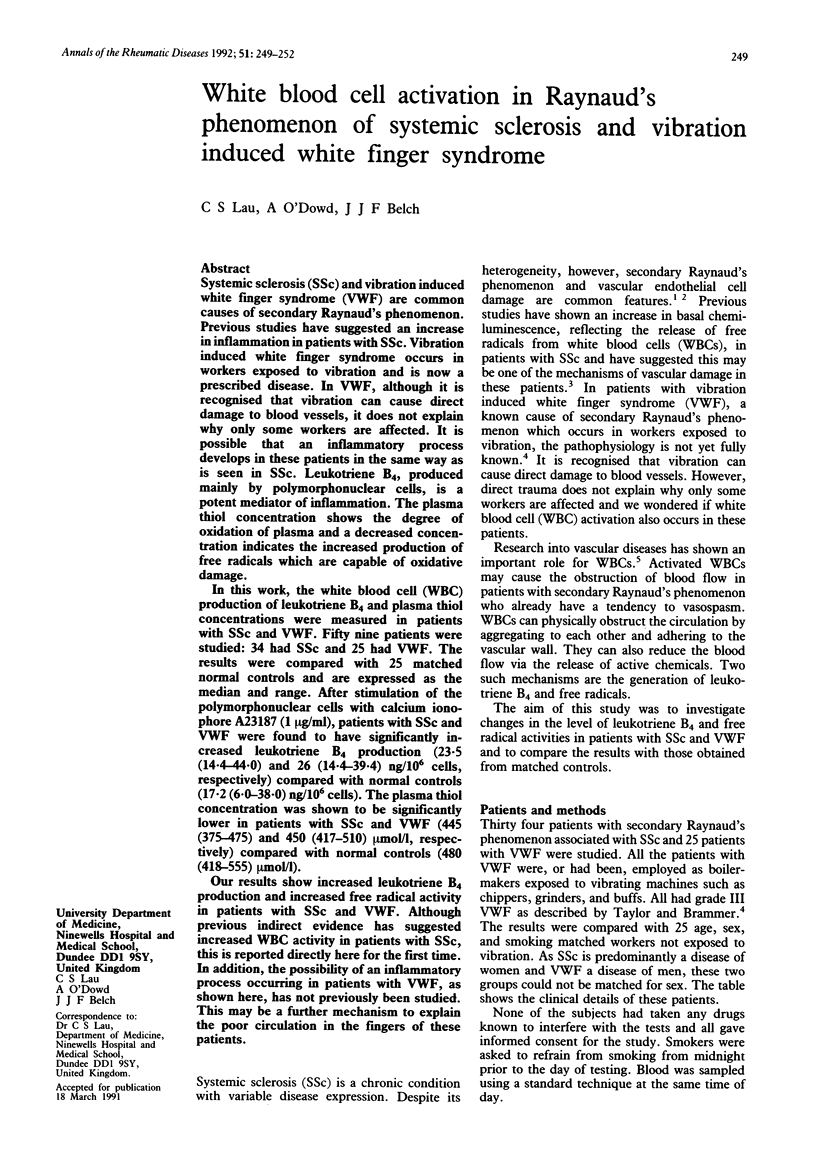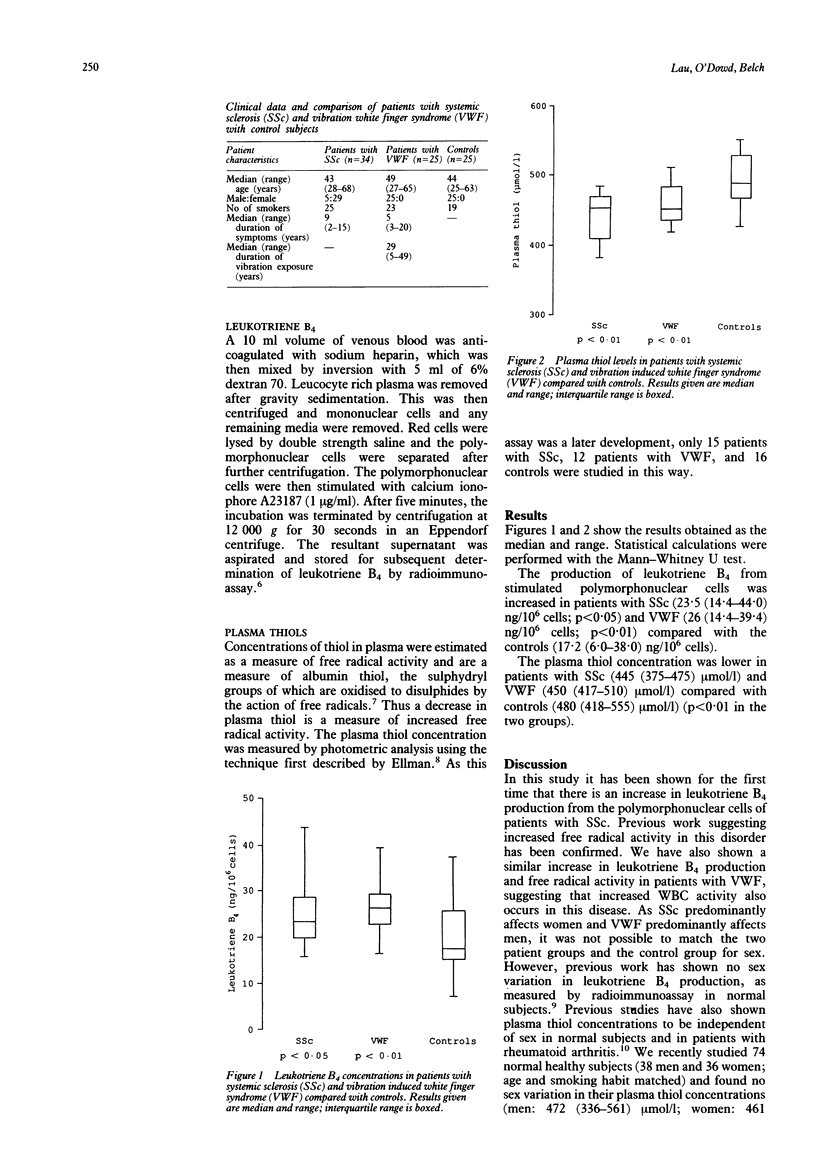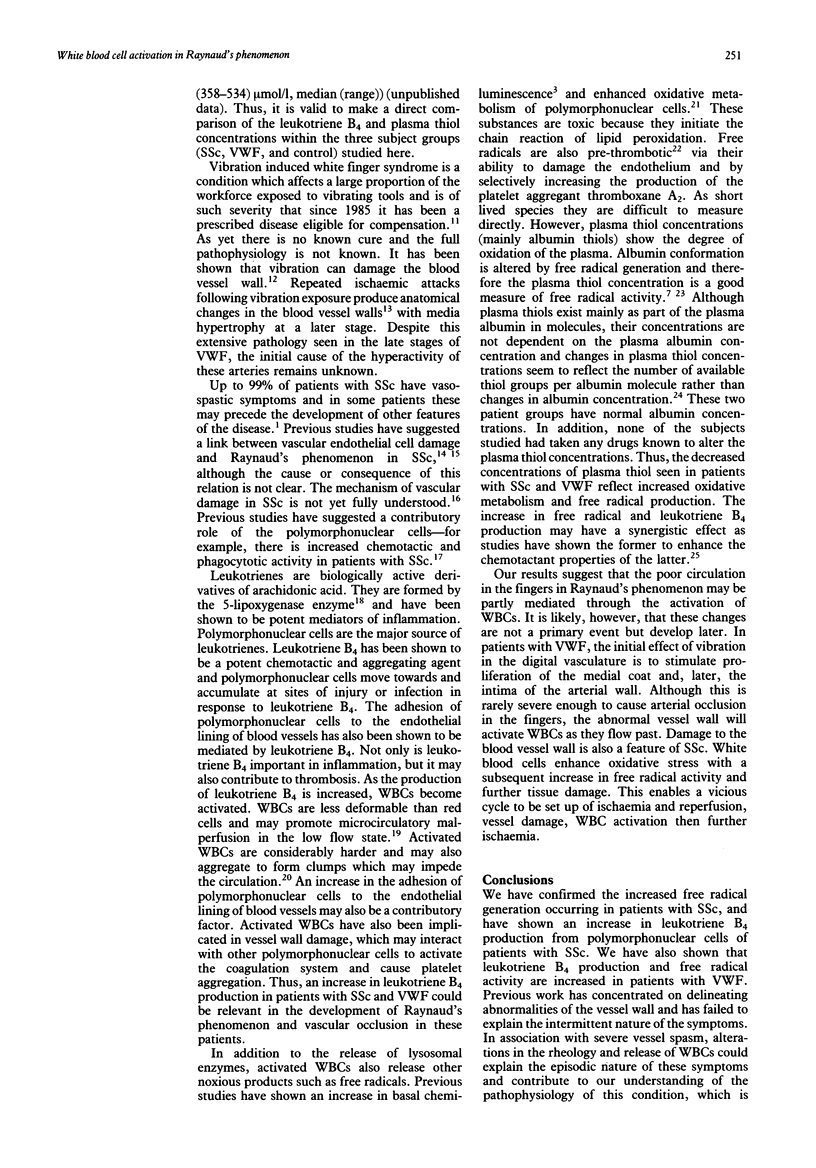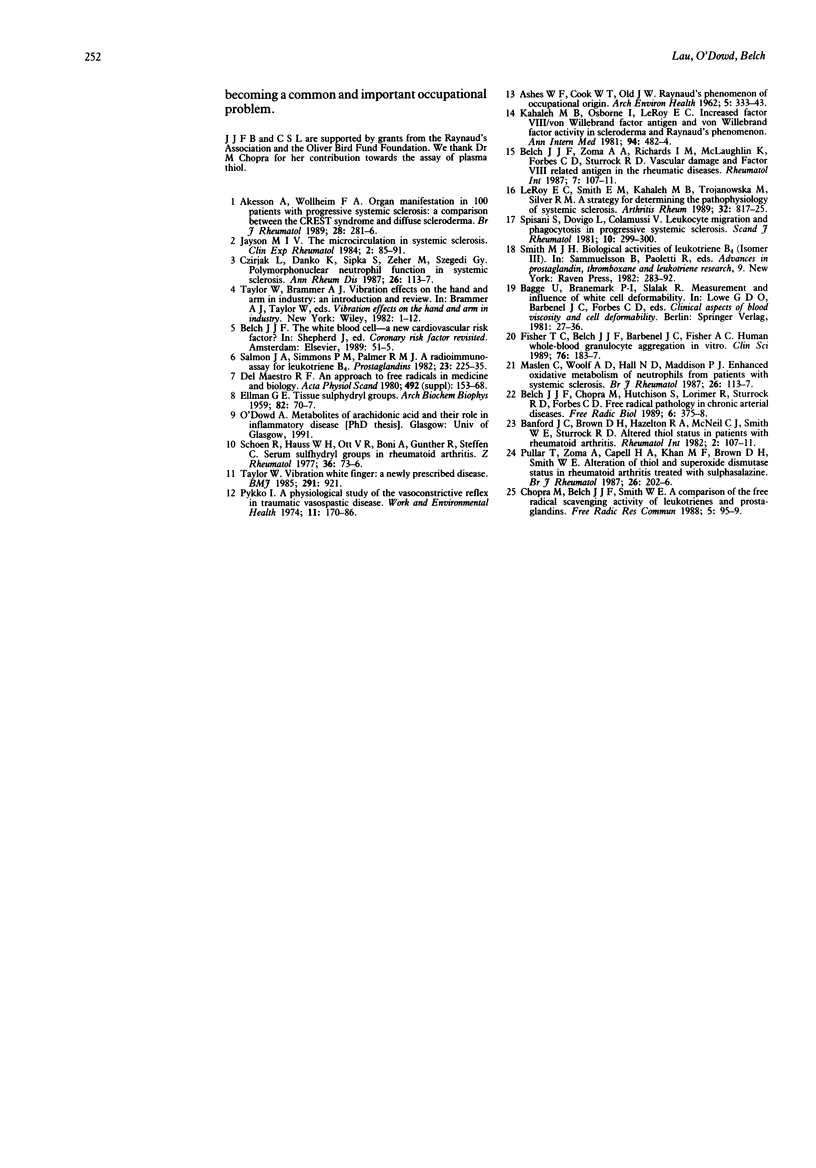Abstract
Systemic sclerosis (SSc) and vibration induced white finger syndrome (VWF) are common causes of secondary Raynaud's phenomenon. Previous studies have suggested an increase in inflammation in patients with SSc. Vibration induced white finger syndrome occurs in workers exposed to vibration and is now a prescribed disease. In VWF, although it is recognised that vibration can cause direct damage to blood vessels, it does not explain why only some workers are affected. It is possible that an inflammatory process develops in these patients in the same way as is seen in SSc. Leukotriene B4, produced mainly by polymorphonuclear cells, is a potent mediator of inflammation. The plasma thiol concentration shows the degree of oxidation of plasma and a decreased concentration indicates the increased production of free radicals which are capable of oxidative damage. In this work, the white blood cell (WBC) production of leukotriene B4 and plasma thiol concentrations were measured in patients with SSc and VWF. Fifty nine patients were studied: 34 had SSc and 25 had VWF. The results were compared with 25 matched normal controls and are expressed as the median and range. After stimulation of the polymorphonuclear cells with calcium ionophore A23187 (1 microgram/ml), patients with SSc and VWF were found to have significantly increased leukotriene B4 production (23.5 (14.4-44.0) and 26 (14.4-39.4) ng/10(6) cells, respectively) compared with normal controls (17.2 (6.0-38.0) ng/10(6) cells). The plasma thiol concentration was shown to be significantly lower in patients with SSc and VWF (445 (375-475) and 450 (417-510) mumol/l, respectively) compared with normal controls (480 (418-555) mumol/l). Our results show increased leukotriene B4 production and increased free radical activity in patients with SSc and VWF. Although previous indirect evidence has suggested increased WBC activity in patients with SSc, this is reported directly here for the first time. In addition, the possibility of an inflammatory process occurring in patients with VWF, as shown here, has not previously been studied. This may be a further mechanism to explain the poor circulation in the fingers of these patients.
Full text
PDF



Selected References
These references are in PubMed. This may not be the complete list of references from this article.
- Akesson A., Wollheim F. A. Organ manifestations in 100 patients with progressive systemic sclerosis: a comparison between the CREST syndrome and diffuse scleroderma. Br J Rheumatol. 1989 Aug;28(4):281–286. doi: 10.1093/rheumatology/28.4.281. [DOI] [PubMed] [Google Scholar]
- Banford J. C., Brown D. H., Hazelton R. A., McNeil C. J., Smith W. E., Sturrock R. D. Altered thiol status in patients with rheumatoid arthritis. Rheumatol Int. 1982;2(3):107–111. doi: 10.1007/BF00541162. [DOI] [PubMed] [Google Scholar]
- Belch J. J., Zoma A. A., Richards I. M., McLaughlin K., Forbes C. D., Sturrock R. D. Vascular damage and factor-VIII-related antigen in the rheumatic diseases. Rheumatol Int. 1987;7(3):107–111. doi: 10.1007/BF00270462. [DOI] [PubMed] [Google Scholar]
- Chopra M., Belch J. J., Smith W. E. A comparison of the free radical scavenging activity of leukotrienes and prostaglandins. Free Radic Res Commun. 1988;5(2):95–99. doi: 10.3109/10715768809066916. [DOI] [PubMed] [Google Scholar]
- Del Maestro R. F. An approach to free radicals in medicine and biology. Acta Physiol Scand Suppl. 1980;492:153–168. [PubMed] [Google Scholar]
- ELLMAN G. L. Tissue sulfhydryl groups. Arch Biochem Biophys. 1959 May;82(1):70–77. doi: 10.1016/0003-9861(59)90090-6. [DOI] [PubMed] [Google Scholar]
- Fisher T. C., Belch J. J., Barbenel J. C., Fisher A. C. Human whole-blood granulocyte aggregation in vitro. Clin Sci (Lond) 1989 Feb;76(2):183–187. doi: 10.1042/cs0760183. [DOI] [PubMed] [Google Scholar]
- Haataja M., Kalliomäki J. L. Serum sulfhydryl groups in rheumatoid arthritis. Z Rheumatol. 1977 Mar-Apr;36(3-4):73–76. [PubMed] [Google Scholar]
- Jayson M. I. The micro-circulation in systemic sclerosis. Clin Exp Rheumatol. 1984 Jan-Mar;2(1):85–91. [PubMed] [Google Scholar]
- Kahaleh M. B., Osborn I., LeRoy E. C. Increased factor VIII/von Willebrand factor antigen and von Willebrand factor activity in scleroderma and in Raynaud's phenomenon. Ann Intern Med. 1981 Apr;94(4 Pt 1):482–484. doi: 10.7326/0003-4819-94-4-482. [DOI] [PubMed] [Google Scholar]
- Leroy E. C., Smith E. A., Kahaleh M. B., Trojanowska M., Silver R. M. A strategy for determining the pathogenesis of systemic sclerosis. Is transforming growth factor beta the answer? Arthritis Rheum. 1989 Jul;32(7):817–825. [PubMed] [Google Scholar]
- Maslen C. L., Hall N. D., Woolf A. D., Maddison P. J. Enhanced oxidative metabolism of neutrophils from patients with systemic sclerosis. Br J Rheumatol. 1987 Apr;26(2):113–117. doi: 10.1093/rheumatology/26.2.113. [DOI] [PubMed] [Google Scholar]
- Pullar T., Zoma A., Capell H. A., Khan M. F., Brown D. H., Smith W. E. Alteration of thiol and superoxide dismutase status in rheumatoid arthritis treated with sulphasalazine. Br J Rheumatol. 1987 Jun;26(3):202–206. doi: 10.1093/rheumatology/26.3.202. [DOI] [PubMed] [Google Scholar]
- Salmon J. A., Simmons P. M., Palmer R. M. A radioimmunoassay for leukotriene B4. Prostaglandins. 1982 Aug;24(2):225–235. doi: 10.1016/0090-6980(82)90148-4. [DOI] [PubMed] [Google Scholar]
- Spisani S., Dovigo L., Colamussi V. Leukocyte migration and phagocytosis in progressive systemic sclerosis. Scand J Rheumatol. 1981;10(4):299–300. doi: 10.3109/03009748109095319. [DOI] [PubMed] [Google Scholar]
- Taylor W. Vibration white finger: a newly prescribed disease. Br Med J (Clin Res Ed) 1985 Oct 5;291(6500):921–922. doi: 10.1136/bmj.291.6500.921. [DOI] [PMC free article] [PubMed] [Google Scholar]


